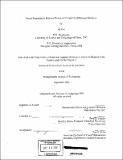Neural responses to relative motion in V1 and V2 of macaque monkeys
Author(s)
Cao, An, 1973-
DownloadFull printable version (6.580Mb)
Other Contributors
Massachusetts Institute of Technology. Dept. of Brain and Cognitive Sciences.
Advisor
Peter H. Schiller.
Terms of use
Metadata
Show full item recordAbstract
Relative motion information is required for solving many complex visual tasks, such as depth perception by motion parallax and motion-induced figure/ground segmentation. However, little is known about the neural substrate for relative motion. To explore the neural mechanisms underlying relative motion, we recorded single unit responses to relative motion in macaque VI and V2. We found that a substantial portion of V1 (62.2%) and V2 (70%) neurons respond to relative motion inputs. These neurons usually show V-shaped tuning curves to relative motion, with minimum response at zero relative motion. They respond predominantly to relative motion rather than to absolute motion. The relative ratio of target velocity to background velocity, rather than the absolute amplitude of either target/background velocity or the difference of the two determines neural responses. In area VI, relative-motion-defined boundaries matching a cell's preferred orientation evoke excitatory responses in a relative motion sensitive neuron. However, the responses are not strong enough to make such a neuron selective to the orientation of the relative-motion-defined boundaries. Relative motion sensitive neurons may participate in segregating objects from a moving background as well as preprocessing complex motion patterns. (cont.) Utilizing a new random-dot stereogram, we tested further if these relative motion sensitive neurons contribute to the processing of motion parallax, as suggested by Nakayama and Loomis (1974). Several factors, i.e., the symmetric V shaped tuning to relative motion, the lack of neurons tuned to the degree of differential motion and the lack of correlation between disparity and relative motion tuning, indicate that those neurons are unlikely to process motion parallax directly. To summarize, we confirm the existence of relative motion sensitive neurons in macaque VI and V2. Although these neurons are not directly involved in processing motion parallax, they facilitate other motion processing such as figure/ground segmentation and motion discontinuity detection.
Description
Thesis (Ph. D.)--Massachusetts Institute of Technology, Dept. of Brain and Cognitive Sciences, 2001. Includes bibliographical references.
Date issued
2001Department
Massachusetts Institute of Technology. Department of Brain and Cognitive SciencesPublisher
Massachusetts Institute of Technology
Keywords
Brain and Cognitive Sciences.